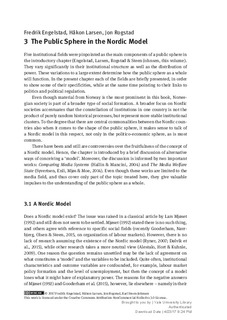| dc.contributor.author | Engelstad, Fredrik | |
| dc.contributor.author | Larsen, Håkon | |
| dc.contributor.author | Rogstad, Jon | |
| dc.date.accessioned | 2017-05-22T11:50:23Z | |
| dc.date.available | 2017-05-22T11:50:23Z | |
| dc.date.created | 2017-05-15T16:20:48Z | |
| dc.date.issued | 2017 | |
| dc.identifier.isbn | 978-3-11-054633-0 | |
| dc.identifier.uri | http://hdl.handle.net/11250/2443151 | |
| dc.description.abstract | Five institutional fields were pinpointed as the main components of a public sphere in the introductory chapter (Engelstad, Larsen, Rogstad & Steen-Johnsen, this volume). They vary significantly in their institutional structure as well as the distribution of power. These variations to a large extent determine how the public sphere as a whole will function. In the present chapter each of the fields are briefly presented, in order to show some of their specificities, while at the same time pointing to their links to politics and political regulation. Even though material from Norway is the most prominent in this book, Norwe-gian society is part of a broader type of social formation. A broader focus on Nordic societies accentuates that the constellation of institutions in one country is not the product of purely random historical processes, but represent more stable institutional clusters. To the degree that there are central commonalities between the Nordic coun-tries also when it comes to the shape of the public sphere, it makes sense to talk of a Nordic model in this respect, not only in the politico-economic sphere, as is most common.There have been and still are controversies over the fruitfulness of the concept of a Nordic model. Hence, the chapter is introduced by a brief discussion of alternative ways of conceiving a ‘model’. Moreover, the discussion is informed by two important works: Comparing Media Systems (Hallin & Mancini, 2004) and The Media Welfare State (Syvertsen, Enli, Mjøs & Moe, 2014). Even though these works are limited to the media field, and thus cover only part of the topic treated here, they give valuable impulses to the understanding of the public sphere as a whole. | nb_NO |
| dc.language.iso | eng | nb_NO |
| dc.publisher | De Gruyter | nb_NO |
| dc.relation.ispartof | Institutional Change in the Public Sphere: Views on the Nordic Model | |
| dc.rights | Navngivelse 4.0 Internasjonal | * |
| dc.rights | Navngivelse 4.0 Internasjonal | * |
| dc.rights.uri | http://creativecommons.org/licenses/by/4.0/deed.no | * |
| dc.rights.uri | http://creativecommons.org/licenses/by/4.0/deed.no | * |
| dc.title | The Public Sphere in the Nordic Model | nb_NO |
| dc.type | Chapter | nb_NO |
| dc.source.pagenumber | 46-70 | nb_NO |
| dc.identifier.doi | 10.1515/9783110546330-004 | |
| dc.identifier.cristin | 1470353 | |
| dc.description.localcode | © 2017 Fredrik Engelstad, Håkon Larsen, Jon Rogstad, Kari Steen-JohnsenThis work is licensed under the Creative Commons Attribution-NonCommercial-NoDerivs 3.0 License | nb_NO |
| cristin.unitcode | 194,67,25,0 | |
| cristin.unitname | Institutt for sosiologi og statsvitenskap | |
| cristin.ispublished | true | |
| cristin.fulltext | original | |
| cristin.qualitycode | 1 | |

